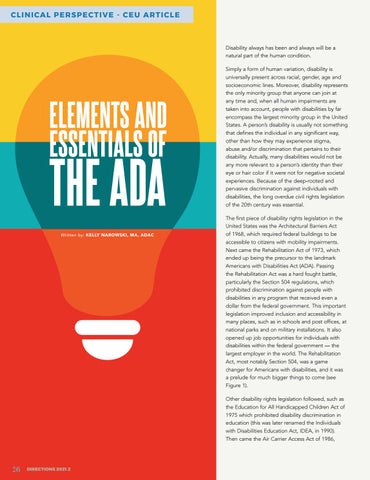CLINICA L P ER S P E CT IV E - CE U AR TI C L E
Disability always has been and always will be a natural part of the human condition.
ELEMENTS AND ESSENTIALS OF
THE ADA Written by: KELLY NAROWSKI, MA, ADAC
Simply a form of human variation, disability is universally present across racial, gender, age and socioeconomic lines. Moreover, disability represents the only minority group that anyone can join at any time and, when all human impairments are taken into account, people with disabilities by far encompass the largest minority group in the United States. A person’s disability is usually not something that defines the individual in any significant way, other than how they may experience stigma, abuse and/or discrimination that pertains to their disability. Actually, many disabilities would not be any more relevant to a person’s identity than their eye or hair color if it were not for negative societal experiences. Because of the deep-rooted and pervasive discrimination against individuals with disabilities, the long overdue civil rights legislation of the 20th century was essential. The first piece of disability rights legislation in the United States was the Architectural Barriers Act of 1968, which required federal buildings to be accessible to citizens with mobility impairments. Next came the Rehabilitation Act of 1973, which ended up being the precursor to the landmark Americans with Disabilities Act (ADA). Passing the Rehabilitation Act was a hard fought battle, particularly the Section 504 regulations, which prohibited discrimination against people with disabilities in any program that received even a dollar from the federal government. This important legislation improved inclusion and accessibility in many places, such as in schools and post offices, at national parks and on military installations. It also opened up job opportunities for individuals with disabilities within the federal government — the largest employer in the world. The Rehabilitation Act, most notably Section 504, was a game changer for Americans with disabilities, and it was a prelude for much bigger things to come (see Figure 1). Other disability rights legislation followed, such as the Education for All Handicapped Children Act of 1975 which prohibited disability discrimination in education (this was later renamed the Individuals with Disabilities Education Act, IDEA, in 1990). Then came the Air Carrier Access Act of 1986,
26
DIRECTIONS 2021.2








